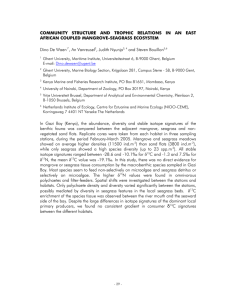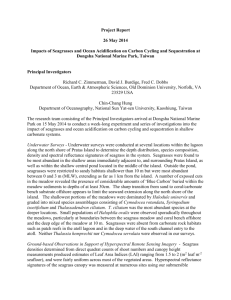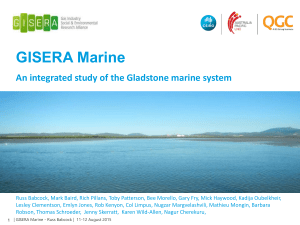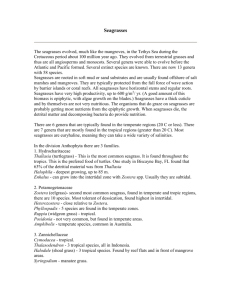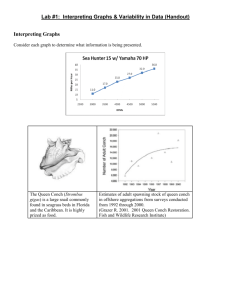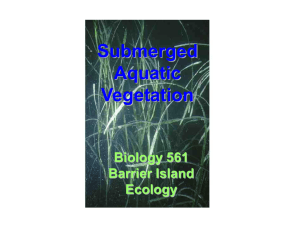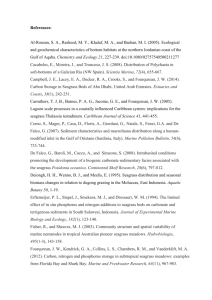What may cause loss of seagrasses?
advertisement
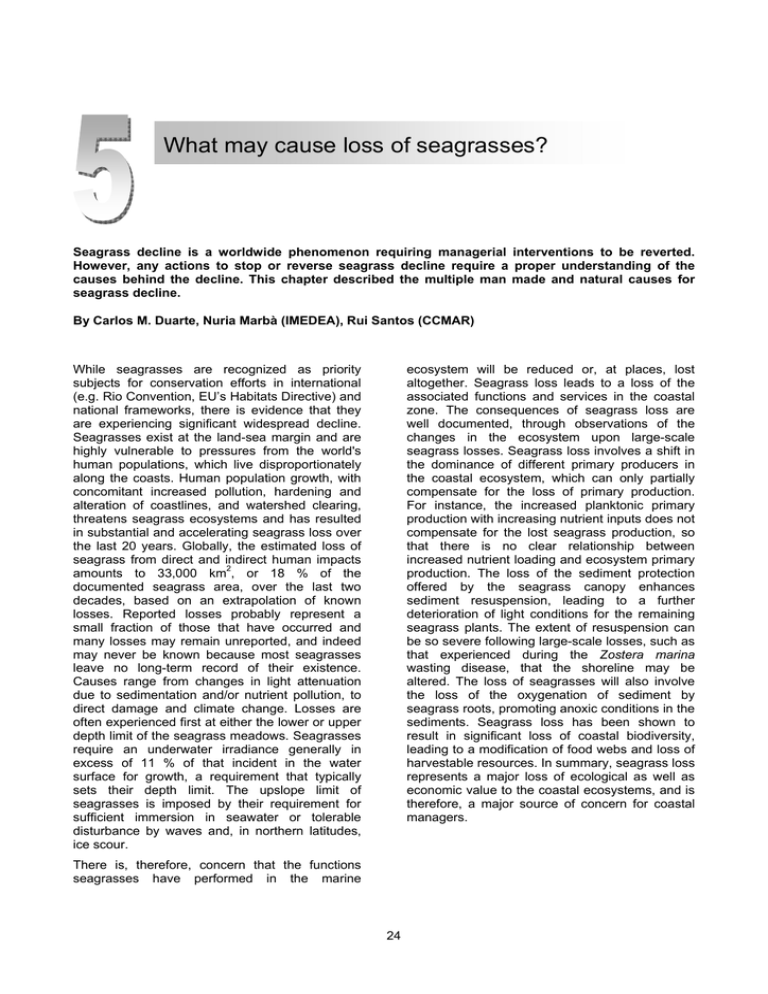
What may cause loss of seagrasses? Seagrass decline is a worldwide phenomenon requiring managerial interventions to be reverted. However, any actions to stop or reverse seagrass decline require a proper understanding of the causes behind the decline. This chapter described the multiple man made and natural causes for seagrass decline. By Carlos M. Duarte, Nuria Marbà (IMEDEA), Rui Santos (CCMAR) ecosystem will be reduced or, at places, lost altogether. Seagrass loss leads to a loss of the associated functions and services in the coastal zone. The consequences of seagrass loss are well documented, through observations of the changes in the ecosystem upon large-scale seagrass losses. Seagrass loss involves a shift in the dominance of different primary producers in the coastal ecosystem, which can only partially compensate for the loss of primary production. For instance, the increased planktonic primary production with increasing nutrient inputs does not compensate for the lost seagrass production, so that there is no clear relationship between increased nutrient loading and ecosystem primary production. The loss of the sediment protection offered by the seagrass canopy enhances sediment resuspension, leading to a further deterioration of light conditions for the remaining seagrass plants. The extent of resuspension can be so severe following large-scale losses, such as that experienced during the Zostera marina wasting disease, that the shoreline may be altered. The loss of seagrasses will also involve the loss of the oxygenation of sediment by seagrass roots, promoting anoxic conditions in the sediments. Seagrass loss has been shown to result in significant loss of coastal biodiversity, leading to a modification of food webs and loss of harvestable resources. In summary, seagrass loss represents a major loss of ecological as well as economic value to the coastal ecosystems, and is therefore, a major source of concern for coastal managers. While seagrasses are recognized as priority subjects for conservation efforts in international (e.g. Rio Convention, EU’s Habitats Directive) and national frameworks, there is evidence that they are experiencing significant widespread decline. Seagrasses exist at the land-sea margin and are highly vulnerable to pressures from the world's human populations, which live disproportionately along the coasts. Human population growth, with concomitant increased pollution, hardening and alteration of coastlines, and watershed clearing, threatens seagrass ecosystems and has resulted in substantial and accelerating seagrass loss over the last 20 years. Globally, the estimated loss of seagrass from direct and indirect human impacts amounts to 33,000 km2, or 18 % of the documented seagrass area, over the last two decades, based on an extrapolation of known losses. Reported losses probably represent a small fraction of those that have occurred and many losses may remain unreported, and indeed may never be known because most seagrasses leave no long-term record of their existence. Causes range from changes in light attenuation due to sedimentation and/or nutrient pollution, to direct damage and climate change. Losses are often experienced first at either the lower or upper depth limit of the seagrass meadows. Seagrasses require an underwater irradiance generally in excess of 11 % of that incident in the water surface for growth, a requirement that typically sets their depth limit. The upslope limit of seagrasses is imposed by their requirement for sufficient immersion in seawater or tolerable disturbance by waves and, in northern latitudes, ice scour. There is, therefore, concern that the functions seagrasses have performed in the marine 24 reduces shoot density and plant biomass, and digging for clams can also exert extensive damage. Many of these impacts remain unquantified as yet, and their long term effects are poorly known. In the Mediterranean, the exploitation of marine resources, and the use of certain types of fishing gear like bottom trawls, has detrimental effects on seagrass beds. Mussel harvest in the Dutch Wadden Sea is believed to be a major factor in the loss of Z. marina and Z. noltii there. Natural and anthropogenic causes The likely primary cause of seagrass loss is reduction in water clarity, both from increased nutrient loading and increased turbidity. Run-off of nutrients and sediments from human activities on land has major impacts in the coastal regions where seagrasses thrive. The relatively high light requirements of seagrasses make them vulnerable to decreases in light penetration of coastal waters. Along temperate, more industrialized coasts, the losses of water clarity come from rapidly increasing inputs of nitrogen and phosphorus from waste discharge, atmospheric deposition, and watershed run-off. In contrast, in tropical areas, the major impacts on water clarity are extensive sediment discharge into coastal waters caused by watershed deforestation and clearing of the mangrove fringe. Aquaculture is growing fast in both the Mediterranean and Atlantic European coast. Aquaculture has been shown to produce major environmental impacts, particularly due to shading, eutrophication and sediment deterioration through excess organic inputs. The effects of fish farms and other aquaculture developments are of concern as areas of productive seagrass habitats are often targeted for such developments, such as in the Mediterranean coast. Mussel culture adversely affects Z. marina and Z. noltii beds in France. Seagrass beds as far as 100 m from fish cages can be impacted by the delivery of feed to the fish. Worldwide, anthropogenic nutrient overenrichment of coastal waters is the factor responsible for much of the reported seagrass decline. The primary cause of nutrient enrichment in estuarine and coastal waters is anthropogenic loading from coastal watersheds. In general, pristine estuaries and coastal seas are nitrogenlimited and nitrogen inputs from point and nonpoint sources causes eutrophication. Increased nutrient loading is widely acknowledged to alter the structure and function of coastal ecosystems. In addition to nutrient inputs from land, increased nutrient inputs are also occurring in coastal areas adjacent to industrialized regions of the world through direct atmospheric deposition of nitrogen, providing additional nutrients that can only be reduced at the source. The introduction of exotic marine organisms, from accidental release, vessel ballast water, hull fouling and aquaculture, remains an area of concern, particularly where the introduced species are competitors for soft bottom substratum such as the alga Caulerpa and the fan worm Sabella spallanzanii. Large scale engineering projects have also resulted in species invasion, such as that by the Lesepian migrant Caulerpa racemosa, introduced through the Suez Canal. The Suez Canal also allowed the introduction of the seagrass Halophila stipulacea into the Mediterranean. Poor land use practices also result in increased soil erosion and the delivery of vast quantities of sediment into coastal waters. Removal of terrestrial vegetation leads to erosion and transport of sediments through rivers and streams to estuaries and coastal waters where the suspended particles create turbidity that reduces water clarity and and increase sedimentation above levels tolerable to seagrass. Direct boat propeller damage to seagrass communities has been recorded, particularly in the Florida Keys, and is prevalent in shallow areas with heavy boat traffic. Boat anchoring leaves scars in Posidonia oceanica landscapes, as do boat moorings. Return of large temperate meadow-forming seagrasses to mooring scars may take decades. Docks and piers shade shoreline seagrass, an effect that may fragment the habitat. Boating may also be associated with organic inputs in areas where boats do not have holding tanks. Direct human impacts to seagrasses, in addition to the major indirect impacts discussed above, threaten the habitat particularly in densely populated areas. Direct impacts from human activity include: i) fishing and aquaculture, ii) introduced exotic species, iii) boating and anchoring, and iv) habitat alteration (dredging, reclamation and coastal construction). Fishing methods such as dredging and trawling may significantly affect seagrasses by direct removal. Damage to Zostera marina by scallop dredging The development of the coastline, particularly related to increased population pressure, leads to alteration and fragmentation of habitats available for seagrasses in coastal waters. Coastal development, construction of ports, marinas and groynes, is usually localized to centers of 25 or geese, represent the main factor structuring some seagrass landscapes, which are characteristically patchy. In contrast, some seagrass species have been able to form longlasting meadows, with meadows of the long-lived Posidonia oceanica dated to > 4000 years, and single clones of Zostera marina dated, using molecular techniques at 3000 years. population. Housing developments impact coastal water quality, and the number of houses in a watershed has been directly correlated to rate of seagrass loss. Construction of the causeway at the southern end of Cockburn Sound, Western Australia, in combination with industrial pollution, destroyed existing seagrass. Construction of roads through shallow waters, without proper consideration to maintaining water flow, may also affect circulation and lead to seagrass loss, such as observed in Cuban coastal waters rendered hypersaline by the effects of road construction over shallow lagoon areas on water exchange. In addition to natural variability of the seagrass habitat, human intervention is becoming a major source of change to seagrass ecosystems, whether by direct physical modification of the habitat by the growing human activity in the coastal zone (e.g. boating, fishing, construction), or through their impact on the quality of waters and sediments to support seagrass growth, as well as changes in the marine food webs linked to the seagrasses. Dredging and reclamation of marine environments, either for extraction of sediments or as part of coastal engineering or construction, can remove seagrasses. Filling of shallow coastal areas, known as reclamation, can directly eliminate seagrass habitat and results in hardening of the shoreline, which further eliminates productive seagrass habitat, as seen throughout Tokyo Bay. Groynes alter sediment transport in the nearshore zone. Dredging removes seagrass habitat as well as the underlying sediment, leaving bare sand at greater depth, resulting in changes to the biological, chemical and physical habitat values that seagrasses support. Beach replenishment may impact adjacent seagrasses by delivering sediment that may shade or bury the seagrasses. Beach nourishment can also impact seagrasses growing in areas where sediments are collected, often at depths < 30m. Human impacts Humans impact seagrass ecosystems both through direct proximal impacts, affecting seagrass meadows locally, and indirect impacts that may affect seagrass meadows far away from the sources of the disturbance. Proximal impacts include mechanical damage and damage created by the construction and maintenance of infrastructures in the coastal zone, as well as effects of eutrophication, siltation, coastal engineering and aquaculture. Indirect impacts include those from global anthropogenic changes, such as global warming, sea level rise, CO2 and UV increase, and anthropogenic impacts on marine biodiversity, such as the large scale modification of the marine food web through fisheries. Indirect impacts are already becoming evident at present. Because of the requirements of seagrass for adequate light and sediment conditions, they are particularly affected by disturbances that modify the water and sediment quality. The seagrass shallow coastal environment is also particularly prone to physical disturbance, whether by waves or turbulence associated with strong storms. Because disturbance is a sporadic phenomenon, seagrass meadows are highly dynamic ecosystems. These dynamics include widespread loss, such as the wasting disease that led to catastrophic die-back of eelgrass (Zostera marina) meadows on both sides of the Atlantic in the 1930s, as well as more recent massive losses such as that in Florida Bay (USA), which is one of the largest areas of seagrass ecosystem worldwide. The causes and the possible role of humanderived impacts in such losses are still uncertain. Strong disturbances, such as damage by hurricanes, can also lead to major seagrass losses. Smaller-scale, more recurrent disturbances, such as that caused by the motion of sand waves in and out of seagrass patches and that caused by large predators, such as dugongs The most unambigious source of human impact to seagrass ecosystems is physical disturbance. This susceptibility derives from multiple causes, all linked to increasing human usage of the coastal zone for transportation, recreation and food production. The coastal zone is becoming an important focus for services to society, since about 40 % of the human population presently inhabit the coastal zone. Direct habitat destruction by land reclamation and port construction is a major source of disturbance to seagrass meadows, due to dredging and landfilling activities as well as the reduction in water transparency associated with both these activities. The construction of new ports is associated with changes in sediment transport patterns, involving both increased erosion and sediment accumulation along the adjacent coast. These changes can exert significant damage on 26 threats coastal tourism poses to seagrasses are in cases direct, as in some cases of purposeful removal of seagrass from beach areas to “improve” beach conditions. Fortunate, there are symptoms that coastal tourism is moving, at least in some areas, to embrace sustainable principles, including the maintenance of ecosystem services, such as those provided by seagrasses, and could well play a role as an agent pressing for seagrass conservation in the future. seagrass ecosystems kilometres away, which can be impacted by both erosion and burial associated with the changing sedimentary dynamics. The operation of the ports also entails substantial stress to the neighboring seagrass meadows, due to reduced transparency and nutrient and contaminant inputs associated with ship traffic and servicing, as well as dredging activities associated with port and navigation-channel maintenance. Rapid increase in sea-based transport, as well as recreational boating activities have led to a major increase in the number and size of ports worldwide, with a parallel increase in the combined disturbance to seagrass meadows. Ship activity also causes disturbance to seagrass through anchoring damage, which can be rather extensive at popular mooring sites, as well as fisheries operation, particularly shallow trawling and smaller-scale activities linked to fisheries, such as clam digging and use of push nets over intertidal and shallow areas and, in extreme cases, dynamite fishing. The exponential growth of aquaculture, the fastest growing food production industry has also led to impacts on seagrasses through shading and physical damage to the seagrass beds, as well as deterioration of water and sediment quality leading to seagrass loss. Increased nutrient inputs, causing eutrophication is a major component to seagrass loss (see below). Increased siltation of coastal waters is also a major human impact on seagrass ecosystems, which derives from changes in land use leading to increased erosion rates and silt export from watersheds. Siltation is a particularly acute problem in other regions of the world, such as SE Asian coastal waters, which receive the highest sediment delivery in the world as a result of high soil erosion rates derived from extensive deforestation and other changes in land use, and may be important in European waters adjacent to deforested watersheds. Siltation severely impacts seagrass meadows through increased light attenuation and burial, leading to seagrass loss and, where less intense siltation occurs, a decline in seagrass diversity, biomass and production. The coastal zone also supports increasing infrastructure, such as pipes and cables for transport of gas, water, energy, and communications, deployment and maintenance of which also entail disturbance to adjacent seagrass meadows. The development of coastal tourism, the fastest growing industry in the world, has also led to a major transformation of the coastal zone in areas with pleasant climates. For instance, about 2/3 of the Mediterranean coastline is presently urbanized, with this fraction exceeding 75 % in the regions with the most developed tourism industry, with harbors and ports occupying 1250 km of the European Mediterranean coastline. Urbanization of the coastline often involves destruction of dunes and sand deposits, promoting beach erosion, a major problem for beach tourism. Beach erosion, however, does not only affect the emerged beach, and is usually propagated to the submarine sand colonized by seagrass, eventually causing seagrass loss. Wave break constructed to prevent beach erosion often create extensive problems, by altering longshore sediment transport patterns, further impacting the seagrass ecosystem. Extraction of marine sand for beach replenishment is only economically feasible at the shallow depths inhabited by seagrasses, which are often impacted by these extraction activities. The Large-scale coastal engineering often alters circulation and salinity distributions, leading to seagrass loss. Hence, seagrass meadows, previously abundant in Dutch coastal areas, are now much reduced in surface, partially related to shifts of coastal waters from marine to brackish or freshwater regimes. Pollution, other than that of nutrients and organic inputs, may be an additional source of human impacts on seagrass ecosystems, although, seagrass appears to be rather resistant to pollution by organic and heavy metal contaminants. These substances may possibly harm some components of the seagrass ecosystem, although such responses have not been examined to a significant extent. Global trade has increased the mobility of marine species, whether purposely, such as aquarium specimens, or inadvertant, such as organisms carried in ballast waters. The increased humanmediated transport of species between geographically distant locations has increased the incidence of invasive species. A case affecting Mediterranean, and probably soon Eastern Pacific seagrasses, is the invasion of the Mediterranean by the tropical algal species Caulerpa taxifolia, which first invaded the French Mediterranean in the early 1980s, apparently released from an 27 natural changes, such as unusual seawater warming, as possible triggers for the decline. Whether indirect human impacts on global processes may have played a role remains untested. aquarium, and has been reported to have expanded since along the French coast to reach the Italian and Spanish (Majorca Island) coasts. C. taxifolia grows rapidly and appears largely to colonize areas devoid of seagrasses, but has been reported to compete for space and resources with Posidonia oceanica off Monaco, being able to damage the Posidonia oceanica meadows. These meadows appear to be particularly vulnerable to invasion by exotic species when already under stress. The species has recently been reported in the Californian coast, raising concerns that it can also cause problems to the seagrass beds there. The Mediterranean Sea has also been invaded by Halophila stipulacea across the Suez Canal, but no damage to the local seagrass meadows has been reported. Hence, despite clear signals of anthropogenic effects on climate components, the responses of the seagrass ecosystem are still unclear, probably due to the still modest size of the changes experienced but also, and perhaps to a greater extent, to the lack of adequate long-term monitoring systems allowing the detection of responses in the seagrass ecosystem. Pathogens Very little is known about seagrass pathogens and related diseases. However, some marine slime moulds of the genus Labyrinthula have been recognised as seagrass pathogens causing the "wasting disease". The symptoms of seagrass infections by these fungi are the presence of small dark brown or black lesions on the leaves, spreading longitudinally covering the totality of the leaf after few weeks. Usually the infections occur on mature leaves, but during severe infections young leaves may also be affected. In early 1930s Labyrinthula zosterae was responsible of dramatic declines of Zostera marina meadows at both north Atlantic coasts. Since then, large scale seagrass losses due to Labyrinthula infections have not been observed although scattered outbreaks of this disease continue effecting Z. marina meadows at local scale (Hemminga and Duarte 2000). Labyrinthula zosterae can also infect Z. noltii producing similar symptoms as in Z. marina. However, infected Z. noltii beds do not exhibit major losses. In fact, species of the genus Labyrinthula occur often on different seagrass beds around the world, without causing seagrass losses. It has been suggested that the interaction between seagrasses and species of slime moulds may turn detrimental for seagrasses under specific environmental conditions that make seagrasses already more vulnerable (Hemminga and Duarte 2000). This could be the case of the wasting disease in the 1930s, which occurred after a long period of high water turbidity. Most of the impacts discussed above result from direct or indirect human intervention at the local scale. However, human activity conducive to large-scale changes at the regional or global scale also exert an important impact on seagrass ecosystems. These effects are remarkably difficult to separate from responses to background natural changes of the highly dynamic coastal ecosystem. These impacts involve the effects of the realized and predicted climate change, and result from changes in sea level, water temperature, UV irradiance, and CO2 concentration (see below). Natural vs. anthropogenic influences Some cause-effect relationships between local seagrass loss and direct human activities, such as increased nutrient and organic loading, constructions on the coastline or boating activity, can be readily demonstrated. For instance, the loss of Zostera marina in a bay on the Atlantic coast of the USA has been shown to be closely correlated to housing development. However, the link between seagrass losses and indirect human influences is more elusive, since the coastal zone is a highly dynamic ecosystem, where many conditions vary simultaneously. Disturbances such as strong storms, hurricanes and typhoons, severely impact seagrass beds, to the point that they may be essential components of the dynamics of seagrass meadows. The difficulties of discriminating between sources of seagrass loss are best illustrated by example. The wasting disease decimated Zostera marina meadows in the 1930s on both sides of the Atlantic. The proximal cause for the loss seems to have been an infection by a fungus, Labyrinthula zosterae, although it may have affected Zostera marina meadows that were already stressed. Hypotheses to account for this widespread loss also point to The scarce reports of seagrass diseases, however, may not reflect a high resistance of seagrasses to infections but the difficulty to detect them. Information about seagrass diseases could increase in the near future with the development of new techniques able to detect microbial plant infections, as is occurring in the field of vascular terrestrial plants. 28 physiological limitations setting the latitudinal limits of seagrass distribution, increasing global temperature will increase species diversity in subtropical regions and allow cold water species to expand their geographic distribution further towards higher latitudes, thereby increasing the importance of seagrass ecosystems on the global scale. Climate extremes and climate change Global climate changes derive, at least partly, from anthropogenic combustion of fossil fuels and changes in land use with increasing concentrations of carbon dioxide and emission of other greenhouse gasses and will most likely have substantial long term impacts on seagrass ecosystems. Climate changes of potential importance for seagrass growth and distribution include global warming, rising sea level, the increase of carbon dioxide in the atmosphere and ocean, and the increasing frequency and strength of storms. While the increase in carbon dioxide can be predicted with relatively high precision, global warming and especially its meteorological implications are more difficult to foresee. Making prediction even more complex, climate changes interact with other human-caused changes in the marine environment. The rise in temperature in the next 25 years will result in a projected increase in sea level of between 10 and 15 cm, mostly because of thermal expansion of the ocean and, to a lesser extent, because of melting glaciers and ice sheets. The rise in sea level may have numerous implications for circulation, tidal amplitude, current and salinity regimes, coastal erosion and water turbidity, each of which could have major negative impacts on local seagrass performance. The projected increase in atmospheric CO2 is expected to affect photosynthesis and growth of seagrasses, particularly increasing seagrass photosynthesis. The increasing levels of dissolved CO2 in seawater may increase the competitive advantage of seagrasses over algae because seagrasses are currently more CO2-limited than algae. The photosynthetic rates of light-saturated seagrass leaves are often limited by the availability of dissolved inorganic carbon, and, since the concentration of CO2 in well-mixed, shallow coastal waters is in equilibrium with the atmosphere, the increase in atmospheric CO2 concentration by 25 %, from 290 ppm to 360 ppm, over the 20th century, may have led to an increase in light-saturated seagrass photosynthesis by as much as 20 %. There is, however, little evidence that such physiological responses have led to observable changes in seagrass ecosystems at present. The expected increase in global temperature may have numerous effects on seagrass performance. Temperature affects almost every aspect of seagrass metabolism, growth and reproduction and also has important implications for geographic patterns of seagrass species abundance and distribution. Progressively increasing temperature may be a major threat to local populations of seagrasses, especially if living close to their low latitude borders of distribution, such as is the case for Posidonia oceanica, Zostera marina and Cymodocea nodosa, which encounter their southern (Posidonia oceanica, Zostera marina) or northern (Cymodocea nodosa) distributional limits in European waters. Seagrass distribution shift could be even greater if oceanic circulation changes in response to global warming, leading to abrupt changes in water temperature beyond those directly resulting from warming, as water masses shift at the edge of present biogeographical boundaries between seagrass floras. Global warming will produce an increase in frequency and strength of storm events, resulting in increased coastal erosion and sediment resuspension with more turbid waters and poorer light conditions for benthic plant communities. Although many species of seagrasses are adapted to, and can survive, periods of low light and partial burial, storm events often reduce growth and survival and require new colonization by seeds to re-establish seagrass beds. Conversely, physical disturbance represents an energetic subsidy and may be of advantage to species diversity and improve growth conditions for climax plant species. Overall, the net effect of increasing frequency and strength of storm events on seagrasses is not clear. While rising temperature may have major negative effects on local seagrass beds, there seems to be less reason for concern for seagrasses on the global scale. When reviewing the literature for effects of temperature on seagrasses there seems to be some bias towards the detrimental effects of high temperature and less focus on the negative impact of low temperatures. Seagrasses probably evolved in warm waters, suggested by the high species diversity of seagrass beds in the IndoPacific tropical region, and although a few genera, such as Zostera, have had great success colonizing cold temperate waters, most species grow in warm waters. It is reasonable to expect that, although there may be no apparent The mean global sea level has risen about 10 – 25 cm over the 20th century, which should have 29 generated an average recession of the global coastline by 10 to 25 m , and, therefore, a large scale erosion of shallow marine sediments. There is little doubt that such changes must have affected seagrasses, which are very sensitive to sediment erosion, although there is little or no direct observational evidence for these changes. Effects of the seawater warming of 0.3 – 0.6 oC over the 20th Century on seagrasses are generally less evident than those of sea level. Temperature affects many processes that determine seagrass growth and reproduction, including photosynthesis, respiration, nutrient uptake, flowering and seed germination. Although observations of increased flowering frequency of Posidonia oceanica in the Mediterranean have been tentatively linked to the seawater temperature increase, there is little evidence at present to suggest any impact of increased temperature as a result of global warming at present. The temperature increase may further impact seagrass ecosystems through effects on other components, such as an increased respiratory rate of the associated microbial communities. Stimulation of microbial respiration would further enhance the problems derived from high organic inputs to seagrass sediments. Summer UV irradiance has greatly increased at high latitudes, and an increase in the northtemperate zone is also becoming evident. Increased UV levels are expected to negatively impact shallow, particularly intertidal, seagrasses. Although seagrass meadows are often nutrient limited, increased nutrient inputs can only be expected to enhance seagrass primary production at very moderate levels at best. Whereas seagrasses, through their low nutrient requirements for growth and their high capacity for internal nutrient recycling are well fitted to cope with low nutrient availability, other primary producers, both micro- and macroalgal, are more efficient, because of greater affinity and higher uptake rates, in using excess nutrient inputs. Coastal eutrophication promotes phytoplankton biomass, which deteriorates the underwater light climate, and the stimulation of the growth of epiphytes and opportunistic macroalgae, which further shade and suffocate seagrasses. The alleviation of nutrient limitation, together with the proliferation of phytoplankton and epiphyte biomass as a result of increased nutrient inputs imply that coastal eutrophication leads to a shift from nutrient limitation to light limitation of ecosystem production, enhanced through competitive interactions between different types of primary producers for light. These effects result in seagrass loss, particularly in the deeper portions of the meadows. The effects of overgrowth by phytoplankton, epiphytes and macroalgae may be attenuated by heavy grazing, which can buffer the negative effects of eutrophication. Eutrophication may, furthermore, have negative effects directly derived from the high resulting nutrient concentration, for high nitrate and ammonium concentrations may be toxic to seagrasses. Eutrophication Whereas research on the effects of eutrophication on seagrass meadows has focussed on the effects of reduced light quality, the deterioration of the sediment conditions may also play a critical role in enhancing the loss of seagrasses. Seagrass sediments are typically rich in organic materials, due to the enhanced particle deposition and trapping under seagrass canopies compared to adjacent bare sediments. Microbial processes are, therefore, stimulated in the seagrass rhizosphere, which, if sufficiently intense lead to the depletion of oxygen and the development of bacterial communities with anaerobic metabolism, which release by-products, such as sulphide and methane, that may be toxic to seagrasses. In order to avoid such toxicity effects, seagrasses pump a significant fraction of the photosynthetic oxygen produced to the roots, which release oxygen to maintain an oxidized microlayer at the root surface. However, eutrophication reduces seagrass primary production both through shading and seagrass loss, thereby reducing the oxygen seagrass roots may release. This allows anaerobic processes and the resulting metabolites Widespread eutrophication of coastal waters derived from the excessive nutrient input to the sea, is leading to a global-scale deterioration of the quality of coastal waters, which is identified as a major loss factor for seagrass meadows worldwide. Human activity presently dominates the global nitrogen cycle, with anthropogenic fixation of atmospheric nitrogen now exceeding natural sources and anthropogenic nitrogen now dominating the reactive nitrogen pools in the atmosphere, and therefore rainwater, of industrialized and agricultural areas. Hence, anthropogenic nitrogen dominates the nitrogen inputs to watersheds, with the human domination of nitrogen fluxes being reflected in a close relationship between nitrate export rate and human population in the world’s watersheds. Tertiary water-treatment plants only achieve a partial reduction in nitrogen inputs to the sea, for nitrogen inputs to the coastal zone are already dominated by direct atmospheric inputs in heavily industrialized or agriculture areas. 30 to accumulate closer to the root surface, increasing the chances of toxic effects to seagrass. At the same time, the increased pelagic primary production leads to a greater input of organic matter to the sediments, enhancing microbial activity and the sediment oxygen deficit, which may increase the production of metabolites from anaerobic microbial metabolism. Both these processes result in the deterioration of the sediment environment to support seagrass growth, leading, through its interaction with the consequences of reduced light availability, to accelerated seagrass loss. Eutrophication effects on sediments may be more acute where sewage is the dominant source of nutrients, for this is discharged along with a high organic load, stimulating microbial activity. Aquaculture activities are becoming increasingly prominent in the shallow, sheltered coastal waters where seagrass meadows abound. Shading and high inputs of organic matter from fish cages have been shown to lead to seagrass decline below and around fish cages, through processes comparable to those of the eutrophication outlined above. Figure 5.1. Propeller scars in intertidal seagrass meadows. Photo: R. Santos. In shallow coastal zones where recreational boats are very numerous, the continuous damages related to anchoring and to propellers (Fig. 5.1) result in important vegetation losses. Mechanical loss The dredging of navigation channels in coastal systems such as estuaries and coastal lagoons Mechanical damage is an important anthropogenic cause of seagrass decline. The removal of the plants and the damage of the shoots and rhizomes result in drastic reductions of seagrass cover. As important as the direct effects are the indirect impacts related to the alteration of the water circulation and sediment dynamics that may increase the erosion of the seagrass prairies, to the sediment re-suspension that increase water turbidity decreasing plant photosynthesis, to the mobilization of contaminants stored in the sediment, to the modification of sediment chemistry and nutrient availability or to the promotion of the competitive ability of seaweed species that may locally out compete the seagrasses. Because seagrasses develop in sandy bottoms they are very susceptible to trawling. Drastic seagrass losses in European coastal zones, from the Northern Sea to the Mediterranean, were caused by trawling. Fishing boats harvesting fish and clams associated to the seagrass habitat, in many cases illegally have reduced severely the seagrass cover and prevent the seagrass reestablishment. Seagrasses are not physically robust and rhizomes are likely to be damaged, and seeds buried too deep to germinate, by activities such as trampling, anchoring, digging, power boat and jet-ski wash. Figure 5.2. Channel dredging in coastal systems. Photo: R. Santos. (Fig. 5.2) may have direct mechanical effects by removing the seagrasses, but often their indirect effects are more important. The re-suspension of the sediments or the remobilization of toxic contaminants stored in the bottom may affect seagrasses. Seagrass populations are likely to survive increased turbidity for short time periods. 31 transport or simply bury the seagrasses. Particularly the construction of solid piers perpendicular to the shore has huge impacts on the sediment transport. Sedimentation will increase near the pier, but important coastal erosion will result downstream. In general, seagrass beds are intolerant of any activity that changes the sediment regime when the change is greater than the natural variation. A striking case of direct mechanical loss of intertidal seagrass meadows occurs in Ria Formosa coastal lagoon, southern Portugal, where 90% of the clams consumed in the country are produced. The beds for clam culture are prepared by destroying the intertidal Zostera noltii meadows with mechanical ploughs and covering the natural sediment with coarser terrestrial sediment (Fig. 5.3). However, prolonged increase in light attenuation will result in loss or damage of meadows. Toxic contaminants can decrease photosynthesis and nitrogen fixation, reducing seagrass growth. Moreover, the sliding of sediments from the channel edges to the bottom compensating the sediment removal may cause important erosion of seagrass beds that develop in the shallow banks. Suction dredging for scallop in northern Europe removed the seagrass Zostera in affected areas while in un-dredged areas the seagrass remained abundant. Dredging increases fragmentation and destabilization of the seagrass meadows, which lead to reduced sedimentation and increased erosion, resulting in a decline over larger areas. Conclusions The current rate of seagrass loss illustrates the imperilled status of these ecosystems and the need for increased public awareness, expanded protective policies and active management. In order to achieve such goals it is important to focus resources to monitor seagrass habitat trends and conserve existing seagrass resources, act to attenuate the causes of seagrass loss, and develop knowledge and technologies to revert ongoing seagrass decline. The widespread loss of seagrasses is largely a consequence of the rapid growth in human activities and transformation of the coastal zone, with the resulting direct and indirect impacts on seagrasses. Global population growth is concentrated in the coastal zone, which also harbors a disproportionate fraction of the world’s wealth. Indeed, some industries linked to the marine environment, such as tourism, maritime transport and aquaculture are rapidly growing. Consequently, human activity in the coastal zone is likely to continue to increase, with a potential for even greater impacts on seagrasses. Figure 5.3. Preparing a clam culture bed over an intertidal seagrass meadow. Photo: R. Santos. Sediment disturbance, siltation, erosion and turbidity resulting from coastal engineering have also been implicated in the decline of seagrass beds world wide. Coastal engineering, including the construction of marinas and piers or the nourishment of the beaches alter the littoral dynamics of the water circulation and sediment 32

